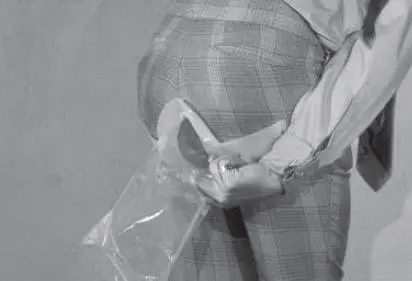At supersonic speeds, your body would be coping with the kind of Q force that used to regularly shake experimental jets to pieces. Dan Fulgham has heard about pilots who ejected at 600-plus miles per hour. “Ejection seats back then had metal wings on each side of the head to keep it from flopping around,” he told me. “When they did autopsies they found the brains had just been emulsified because of the tremendous vibration of the head between those steel plates.” Whenever they can, fighter pilots stay with a crippled jet until they can slow it down, reducing the Q load and raising their odds of survival. Red Bull has cause to be nervous about Baumgartner. He could be vibrated to death inside his suit as he approaches or surpasses the speed of sound.
The immediate and dire consequence of plunging into thin air is lack of oxygen. At 35,000 feet, a human being has 30 to 60 seconds of “useful consciousness.” You’d definitely want to be first in line at the emergency exit. I can tell you what it’s like to wander out to the edges of useful consciousness. As a prerequisite for the weightless flight I undertook in chapter 5, the engineering students and I took a NASA aerospace physiology seminar that included a hypoxia (not enough oxygen) demonstration inside the Johnson Space Center altitude chamber. By pumping air out of a sealed chamber, technicians can simulate the atmosphere at any altitude, all the way to near-total vacuum—a big box of outer space. Space agency personnel use these chambers to test spacesuits and other equipment that will be exposed to the vacuum of space.
After about a minute with our oxygen masks off at 25,000 feet—where one has two to five minutes of useful consciousness—we were asked to complete a list of mental tasks. One question read, “Subtract 20 from the year you were born.” I felt fine, but I remember puzzling over it, feeling utterly stumped, and moving on. One of the last questions was: “What does NASA stand for?” I obviously know this, but my answer reads, “N.”
More than useful consciousness you would need luck, given that 400 other panicked passengers are bailing out with you, creating a significant danger of tangled parachute lines and canopies. But it would be possible to survive, provided you stay with the plane until it slows to a more survivable speed. You might experience pain, but nothing major. At higher altitudes, as air pressure drops, air inside the body’s own chambers tries to unbutton its shorts and expand. A pocket of gas inside an unfilled tooth cavity may press painfully on nerves. Same sort of thing happens to air in the sinus cavities—particularly if they’re congested. Even gas dissolved in the cerebrospinal fluid inside the brain’s ventricles tries to expand. If I’d had a hole in my skull, my fellow students in the altitude chamber could have watched my brain bulge out of it. [83] A proven fact. In 1941, scientists at the Mayo Foundation’s Laboratory for Research in Aviation Medicine convinced a woman with a postsurgical hole in her cranium to sit inside their altitude chamber while they took her up to 28,000 feet. The patient (and never was the term patient more apt) was positioned in front of a centimeter scale while the researchers, like golf caddies, planted a small triangular flag in the hole to mark the spot. At 28,000 feet, the little flag on her brain had risen a full centimeter.
The gas expansion you are most likely to notice is in your digestive tract. At 25,000 feet, air in the stomach, for example, expands threefold. “Go ahead and fire it off,” our instructor told us, as if eleven male college students needed an invitation.
BAUMGARTNER IS TAKING a break. He’s slumped in a chair with his helmet in his lap, sipping water. (Perris SkyVenture doesn’t stock Red Bull.) Art Thompson, the project technical director, is in a good mood. The suit is working well, and Baumgartner feels comfortable in it. (As comfortable as anyone ever feels in a spacesuit. As spacesuit historian Harold McMann put it, “It’s not a nice place to be. It’s not even a nice place to visit.”)
As you read this, there’s a good chance Felix Baumgartner will have completed his history-making jump. As I write this, I don’t how it turns out. I am cautiously optimistic. Skydiving from extremely high altitude is risky, but probably not as risky as Baumgartner’s more typical occupation—jumping from extremely low altitude. If something starts to go wrong during a space dive, you have five minutes to figure out how to remedy it. On a BASE jump, you don’t have five seconds. BASE jumpers don’t carry reserve chutes, as there’s no time to deploy them. “That’s why they don’t tend to have a long…” Thompson searches for the right word.
“Life span?” I offer.
“Career.”
Thompson says he isn’t worried. “Eventually, most BASE jumpers get complacent, but Felix is really anal about what he does. That’s what keeps him alive.”
Brave and anal: the ideal space explorer. Though you don’t find “anal” on any of those lists of recommended astronaut attributes. NASA doesn’t really use words like anal . Unless they have to.
14. SEPARATION ANXIETY
The Continuing Saga of Zero-Gravity Elimination

It is probably not the first time that a bunch of guys got together and installed a closed-circuit video camera in a toilet bowl at a government agency. It is surely the first time it has happened with the blessings and financial backing of the agency. And that the monitor has been mounted right there in the bathroom, angled for the viewing ease of the person on the toilet.
On the wall to the sitter’s left is a small plastic sign:
Positional Trainer
Sit Down on Trainer Seat and Spread Buttocks
The Johnson Space Center “potty cam,” as it is more casually known, is an astronaut training aid. It provides a vivid, arresting perspective on something you’ve had intimate contact with all your life but never really seen. Perhaps not unlike viewing one’s home planet from space for the first time. Positioning is critical because the opening to a Space Shuttle toilet is 4 inches across, as opposed to the 18-inch maw we are accustomed to on Earth. Jim Broyan, a waste-water engineer who designs toilets and other amenities for NASA astronauts, is showing me around. Broyan has a reedy build and an angular face. He peers at his visitor over the top of a pair of wire-frame glasses. He possesses a stealthy deadpan wit and is, I imagine, tremendous fun to work with.
“The camera enables you to see if your butt, your…” Broyan pauses in search of a better word: not more polite, just more precise. “… anus lines up with the center.” Without gravity, you can’t reliably gauge your position by feel. You are not really sitting on the seat. You are hovering in close proximity. The tendency, says Broyan, is to touch down too far back. Then your angle of approach is off, and you sully the back of the transport tube and plug some of the air holes that encircle the rim. Bad, bad move. Space toilets operate like shop vacs; “contributions,” to use Broyan’s word, are guided along, or “entrained,” by flowing air rather than by water and gravity, two things in short-to-nonexistent supply in an orbiting spacecraft. Plugged air holes can disable the toilet. Additionally, if you gum up the holes, it is then your responsibility to clean them out—a task Broyan understates as “arduous.”
The room with the potty cam is a working bathroom, complete with sink and paper towel dispenser, but it functions primarily as a classroom. Every astronaut must be potty-trained by Scott Weinstein, who has just joined us. Weinstein is also in charge of galley training—how to eat in space. His is a one-of-a-kind teaching position: taking the most skilled, credentialed, highest-achieving individuals in the world and putting them back in nursery school. Everything these men and women learned as toddlers—how to cross a room, how to use a spoon, how to sit on a toilet—must be relearned for space.
Читать дальше













